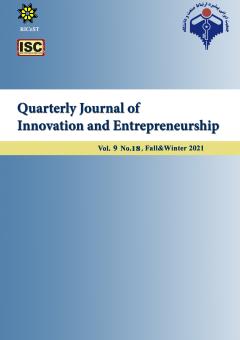Progress in Biological Sciences in Iran: A Comparative Study
Subject Areas : Generalseyed Mahdi Seyedi 1 , Maryam AmiriRad 2 , hassan ebrahimzadeh maboud 3 , Laila Alibiglou 4
1 - National Institute of Genetic Engineering and Biotechnology, Tehran, Iran
2 - Department of Plant Biology, School of Biology, College of Science, University of Tehran, Tehran, Iran
3 - Professor, Department of Plant Biology, School of Biology, College of Science, University of Tehran, Tehran, Iran; and Member of Biology group of Academy of sciences of I.R of Iran.
4 - Department of Neuroscience, School of Advanced Technologies in Medicine, Iran University of Medical Sciences (IUMS), Tehran, Iran
Keywords: Biological sciences, Scientific papers, Quantity, Quality, University, Industry,
Abstract :
Today, the biological sciences are one the most important parts of the basic sciences. This explains why most industrial countries are heavily investing in it. In the USA, more than half of all federal government support in science is allocated to the biological sciences. In the EU, more than 22 million people are employed in professions relating to the biological sciences. In Iran, Science and Technology Initiatives consider basic sciences as one of the important parts of science and most universities educate students in the biological sciences. In addition, some incubators and science parks are devoted to biological sciences. To evaluate the research in biological sciences in Iran, we compared the quantity, quality, international cooperation, and the cooperation between academia and industry with Asian and global universities. To do this, we used Leiden ranking results in two time frames, namely 2008-2011 and 2012-2015. The results demonstrate that Iran stands at a relatively good point based on the number of publications. However, greater efforts are necessary to avoid falling behind in terms of rank. Additionally, this study shows that the quality of publications requires significant improvements. Furthermore, international cooperation of universities should be expanded. Poor industrial cooperation between university and industry is mainly due to the lack of related industries. In conclusion, a detailed plan should be developed to ensure leadership in biological sciences and achieve scientific authority in the field
1. آراسته، حمیدرضا (1387). جهانی شدن و آموزش عالی در دنیای در حال تغییر. رهیافت. 42 ،39-45.
2. سیدی، سیدمهدی (1397). پتنت در زیست فناوری و اهمیت آن در ارتباط دانشگاه و صنعت. فصلنامه نوآوری و ارزش آفرینی. 7 (13)، 1-24.
3. سیدی، سیدمهدی (1398). رصد کمیت مقالات علمی در حوزه زیست پزشکی و سلامت در جهان، آسیا، و وضعیت دانشگاههای علوم پزشکی کشور با تأکید بر مرجعیت علمی. نشريه فرهنگ و ارتقاء سلامت. ۳ (۱)، ۵۷-۶۴.
4. صفدري رنجبر، مصطفی؛ توکلی، غلامرضا و سیدرضا سلامی. (1395). همکاری¬های علمی و فناورانه میان دانشگاه و صنعت (روند تاریخی، اهداف، چالش ها و سازوکارها). دوفصلنامه توسعه تکنولوژي صنعتی. 27، 5-16.
5. فشالنج، لیلا؛ بازرگان، عباس. (1392). چگونگی بین¬المللی شدن یک دانشگاه در کارکردهای آموزش، پژوهش و خدمات تخصصی: موردی از یک دانشگاه بین¬المللی. فصلنامه مدیریت و برنامه¬ریزی در نظام¬های آموزشی. 7 (2 و 13)، 9 - 27.
6. Altbach P. (2004). Globalisation and the university: Myths and realities in an unequal world. Tertiary Education and Management. 10, 3–25.
7. Altbach Ph. (2006). The dilemmas of ranking. International higher education. 42: 2-3.
8. Byram M. (2018). Internationalisation in higher education–an internationalist perspective. On the Horizon. 26(2), 148-156.
9. Ehsani V, Azami M, Najafi SMB, Soheili F. (2017). The Effectiveness of Iran Ever-growing Research in Expanding Knowledge Boundaries(Persian). National Studies on Librarianship and Information Organization. 27(2), 123-140.
10. Leiden. Indicators, Retrieved 2013, from http://www. leidenranking.com/information/indicators.
11. Leiden. Indicators, Retrieved 2017, from http://www. leidenranking.com/information/indicators.
12. Liu NC. (2007). Research Universities in China: Differentiation, Classification, and Future World-Class Status. In: Altbach, P. G. – Balán, J. (eds): World Class Worldwide: Transforming Research Universities in Asia and Latin America. Baltimore: The John Hopkins University Press 54–69.
13. Liu NC. (2015). The story of academic ranking of world universities. International Higher Education. 54, 2-3.
14. Phan PH. (2006). The effectiveness of university technology transfer: Lessons learned from quantative and qualitative Research in the us and the U.K. Working paper in economics. Rensselaer polytechnic Institute.
15. Publications Office of the European Union (2012). Innovating for Sustainable Growth - A Bioeconomy for Europe. Luxembourg: European Commission — 60 pp.
16. Rodinov DG, Rudskaia IA & Kushneva OA. ( 2014). The importance of the university world rankings in the context of globalization. Life science journal. 11(10), 422 -446.
17. Rynkun R. (2007). Collaboration between university research and industry: innovation process. Master's Thesis in International Marketing Program.
18. Severson. (2005). Models of University-Industry Cooperation. Journal of Industry-Academia-Government Collaboration. 1(2).
19. Zhiyun L. (2008). Mission of Modern Universities and Development of Modern society. Us- china education Review. USA.
Available from: http://biology.brown.edu/
Available from: http://www.biotech.ca
Available from: http://www.leader.ir/
Available from:
http://www.shanghairanking.com/
Available from:
http://www.timeshighereducation.co.uk/
Available from:
http://www.topuniversities.com/
Available from:
https://clarivate.com/webofsciencegroup/
Available from:
https://colleges.niche.com/rankings/
Available from: https://www.bls.gov/
Available from:
https://www.leidenranking.com/


